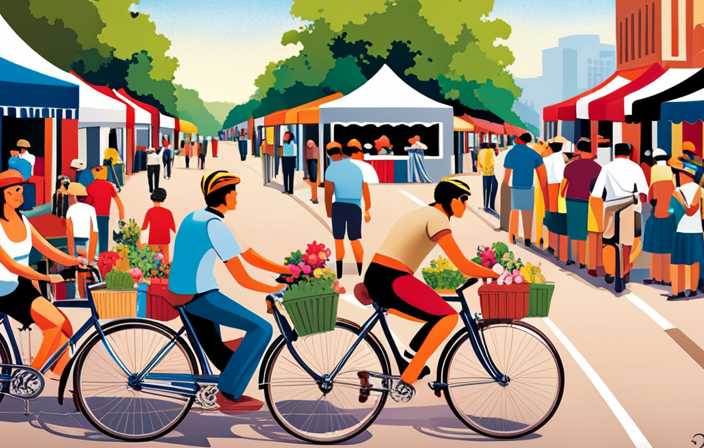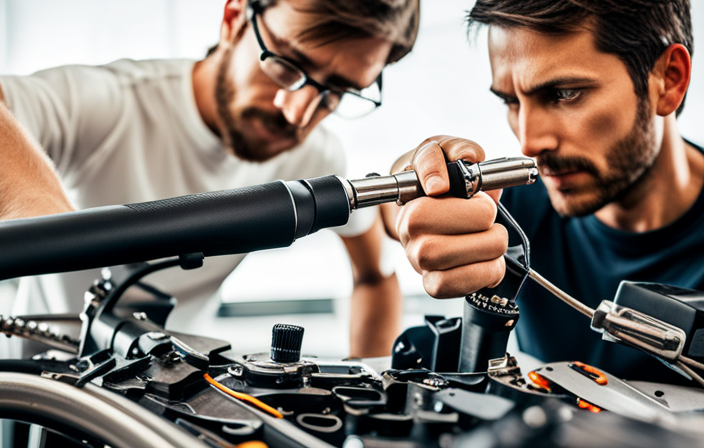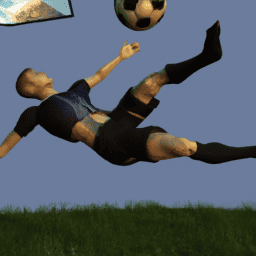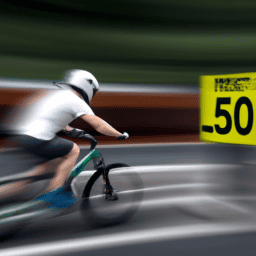Are you thinking about selling your bike but don’t know where to begin? Look no further! In this article, I will guide you through the top places to sell your cherished two-wheeler.
From online marketplace platforms to local bicycle shops, bike swap events to social media groups, we’ll explore a range of options to help you find the perfect buyer.
So, whether you’re a seasoned cyclist or just looking to upgrade, let’s dive in and discover the ideal place to sell your bicycle!
Key Takeaways
- Online marketplace platforms like eBay, Craigslist, Facebook Marketplace, and local buy/sell groups offer a wide reach and potential buyers from all over. They provide detailed listings with pictures, specifications, and pricing information, as well as built-in messaging systems for communication.
- Local bicycle shops provide the convenience and assistance in the selling process, with knowledgeable staff for bike assessment. They may also offer bike repair services and trade-in programs for credit towards a new bike. Supporting local cycling shops also promotes the local cycling community.
- Bike swap events, flea markets, and community events are great opportunities to connect with fellow cyclists and potential buyers. These events attract a targeted audience of knowledgeable and passionate buyers, often including cycling clubs and enthusiasts. Some events may also offer bike repair workshops to showcase the quality of the bikes.
- Social media groups, forums, and classified ads provide a wide reach and connection with potential buyers. Utilizing social media influencers and creating a personal website can increase visibility. Engaging with an active community of bike enthusiasts and placing traditional classified ads in local newspapers can also be effective strategies.
Online Marketplace Platforms
The best place to sell my bicycle online is on marketplace platforms. These online auction platforms provide a wide reach and attract potential buyers from all over. Platforms like eBay and Craigslist have established themselves as reliable and popular choices for selling used items, including bicycles. Utilizing social media marketplace strategies, such as posting on Facebook Marketplace or joining local buy/sell groups, can also increase visibility and attract interested buyers. By using these platforms, I can easily create a detailed listing with pictures, specifications, and pricing information. Additionally, these platforms often have built-in messaging systems that allow for easy communication between buyers and sellers.
Now, let’s explore another option for selling my bicycle: local bicycle shops.
Local Bicycle Shops
Local bicycle shops are a good option for selling your bike. They offer several benefits that can make the process easier and more convenient. Here are some reasons why you should consider selling your bike at a local shop:
-
Expertise: Local bike shops have knowledgeable staff who can provide accurate assessments of your bike’s value and help you set a fair price.
-
Convenience: You can simply bring your bike to the shop and let them handle the selling process for you.
-
Local bike repair services: If your bike needs any repairs or maintenance before selling, the shop can take care of it.
-
Bike trade-in programs: Some shops offer trade-in programs where you can exchange your old bike for credit towards a new one.
Selling your bike at a local shop not only ensures a hassle-free experience but also supports your local cycling community.
Speaking of community, another option to consider is participating in bike swap events and flea markets.
Bike Swap Events and Flea Markets
When it comes to selling my bicycle, I’ve found that bike swap events and flea markets can be great options. These local community events are a perfect opportunity to connect with fellow cyclists and potential buyers.
To make sure I don’t miss out on any upcoming events, I always check event listings in my area. It’s a convenient way to find out where and when these events are happening so I can plan accordingly.
Local community events
One great place to sell my bicycle is at a community event. These events often attract a diverse crowd of people who are interested in bikes and cycling.
At these events, you can find bike repair workshops where enthusiasts gather to learn and share their knowledge about bike maintenance and repairs. It’s a great opportunity to showcase the quality and condition of your bike to potential buyers.
Additionally, many cycling clubs often participate in these events, which means there will be enthusiasts who are actively looking for new bikes to add to their collection. So, by selling your bicycle at a community event, you can reach a targeted audience of bike lovers who are knowledgeable and passionate about cycling.
After exploring the local community events, the next step is to check event listings to find specific events that cater to bike enthusiasts.
Check event listings
If you want to find specific events that cater to bike enthusiasts, you should check event listings. This is a great way to discover local events such as bike races, bike swaps, or group rides that are happening in your area.
Event listings can be found online, on community bulletin boards, or in local newspapers. By checking these listings regularly, you can stay updated on upcoming events and plan accordingly.
Additionally, exploring online classifieds can also be helpful in finding events related to bicycles. Many people advertise bike-related events on these platforms, making it easier for you to find events that interest you.
By checking event listings and online classifieds, you can ensure that you don’t miss out on any exciting bike-related events happening near you.
Moving forward, another valuable resource for finding potential buyers for your bicycle are social media groups and forums.
Social Media Groups and Forums
Selling my bicycle on social media groups and forums is the best option. These platforms provide a wide reach and allow me to connect with potential buyers who are actively interested in purchasing bicycles. Utilizing social media influencers can greatly enhance the visibility of my listing, as their followers trust their recommendations. Additionally, creating a personal website dedicated to selling bicycles can give me a professional edge and provide a centralized location for interested buyers to find information about the bike I am selling.
To emphasize the benefits of selling on social media groups and forums, consider the following table:
| Advantages | Disadvantages |
|---|---|
| Wide reach of potential buyers | Dealing with low-ball offers |
| Active community of bike enthusiasts | Negotiating prices |
| Ability to showcase the bike’s features with photos and videos | Potential for scammers |
Moving on to the next section about classified ads in local newspapers…
Classified Ads in Local Newspapers
Classified ads in local newspapers can provide a traditional yet effective method for reaching potential buyers for my bicycle. Placing a classified ad in a local newspaper allows me to target a specific audience within my community who may be interested in purchasing a bicycle. These ads often reach a wide range of individuals, including those who may not be actively searching online or browsing social media groups. By highlighting the key features and benefits of my bicycle, I can grab the attention of potential buyers and increase the chances of a successful sale.
However, it’s important to keep in mind that classified ads in local newspapers may have a limited reach compared to online platforms.
Transitioning to the next section, bicycle co-ops and nonprofit organizations can also be a great avenue for selling my bicycle.
Bicycle Co-ops and Nonprofit Organizations
When considering what to do with your bicycle, one option is to donate it to a nonprofit organization. Not only will you be helping a cause, but you’ll also be giving your bike a new life and purpose.
Additionally, some organizations offer consignment services, allowing you to sell your bike while supporting a good cause. This can be a great way to ensure that your bike goes to someone who’ll truly appreciate it, while also benefiting a nonprofit organization.
Donate your bike for a cause
Consider donating your bike to a cause and make a positive impact on someone’s life. Donating your bicycle for charity is a great way to give back to the community and help those in need. By donating, you can support organizations that organize bike drives to provide transportation for those who cannot afford it.
Here are five reasons why donating your bike is a worthwhile option:
- Help someone in need by providing them with a means of transportation.
- Reduce waste and promote sustainability by giving your bike a second life.
- Support local nonprofit organizations that strive to improve the community.
- Make a difference in the lives of disadvantaged individuals who may rely on bikes for daily transportation.
- Feel a sense of fulfillment and joy knowing that your bike is being used for a good cause.
Some organizations offer consignment services, providing another option for selling your bike.
Some organizations offer consignment services
Some organizations also offer consignment services, giving you another option to sell your bike. Consignment services work by allowing you to leave your bike with the organization, who will then sell it on your behalf. This can be a great option if you don’t have the time or expertise to sell your bike yourself.
One of the benefits of consignment services is that the organization will handle all the marketing and selling for you. They will take professional photos of your bike, write a compelling description, and handle all the inquiries from potential buyers. Additionally, consignment services often have a wide network of potential buyers, increasing the chances of selling your bike quickly.
If you’re interested in exploring consignment services, keep in mind that they usually take a commission from the final sale price.
Now, let’s talk about another option: online auctions.
Online Auctions
When it comes to selling your bicycle online, there are a few key points to consider.
Bidding platforms like Proxibid offer a wide range of options for buyers and sellers, making it a popular choice for those looking to sell their bikes.
Additionally, specialized bicycle auction websites cater specifically to the cycling community, providing a targeted audience for your listing.
These platforms provide a convenient and effective way to reach potential buyers and maximize the value of your bicycle.
Bidding platforms like Proxibid
Bidding platforms like Proxibid are a great option to sell my bicycle. I have found that these platforms offer a unique and exciting live bidding experience for both buyers and sellers. It allows me to showcase my bicycle to a wide audience of potential buyers who are actively engaged in the bidding process.
One of the advantages of using bidding platforms is the transparency in seller fees. Unlike other online auction sites, Proxibid clearly outlines the fees associated with selling my bicycle, ensuring that there are no hidden surprises. This allows me to accurately calculate my potential earnings from the sale.
Furthermore, bidding platforms like Proxibid provide a sense of security and trust for both buyers and sellers. The platform has a reputation for hosting reputable sellers and buyers, making it a reliable place to sell my bicycle.
Transitioning into the subsequent section about ‘specialized bicycle auction websites’, there are also other options available for selling my bicycle.
Specialized bicycle auction websites
If you’re looking for a more targeted audience, specialized bicycle auction websites offer a focused platform to showcase your bike. These websites cater specifically to bicycle enthusiasts and collectors, ensuring that your bike will be seen by people who appreciate its value and quality. Specialized bicycle forums are a great place to start, as they attract individuals with a deep knowledge and passion for cycling. Additionally, high-end bicycle consignment platforms provide a way to sell your bike at a premium price, as they specialize in connecting sellers with buyers who are willing to pay top dollar for high-quality bicycles. By utilizing these specialized platforms, you can increase your chances of finding the right buyer for your bike.
Transitioning into the next section, another effective way to sell your bike is through word of mouth.
Word of Mouth
You should ask your friends and family for recommendations on the best place to sell your bicycle. Referrals and recommendations are a powerful way to find trustworthy options.
When it comes to selling your bicycle, word of mouth can be incredibly helpful in finding the right platform or buyer. By reaching out to those you trust, you can gather valuable insights and experiences from people who have already navigated the process. Building a reputation through word of mouth is essential, as it ensures that you are connecting with reliable buyers who have a genuine interest in purchasing your bicycle.
Once you have gathered these recommendations, you can explore local online classifieds to expand your reach and find potential buyers beyond your immediate circle.
Local Online Classifieds
Consider exploring local online classifieds to expand your reach and connect with potential buyers in your area. Online classifieds are a convenient and effective way to sell your bicycle quickly. Through these platforms, you can showcase your bike’s features, provide detailed descriptions, and upload high-quality photos to attract interested buyers. Additionally, online classifieds allow you to communicate directly with potential buyers, negotiate prices, and arrange meetups. To further enhance your selling experience, you can also consider reaching out to local bicycle co-ops. These community-based organizations often have a strong network of cyclists who may be interested in purchasing your bike. By leveraging both online classifieds and bicycle co-ops, you can increase your chances of finding the right buyer for your bicycle. Moving forward, let’s explore another option: bicycle rental companies.
Bicycle Rental Companies
One option for expanding your reach and connecting with potential buyers in your area is to check out local bicycle rental companies. These companies often have a customer base that is interested in cycling and may be looking to purchase a bike of their own. By reaching out to these companies, you can inquire about the possibility of advertising your bicycle for sale to their customers. This can be a great way to target individuals who are already interested in cycling and may be in the market for a new bike.
In addition to exploring local online classifieds, reaching out to bicycle rental companies can help you maximize your chances of finding the right buyer for your bicycle.
Transitioning into the next section, another option to consider is utilizing university or college bulletin boards.
University or College Bulletin Boards
When it comes to selling a bicycle, one potential avenue to explore is university or college bulletin boards. These bulletin boards are a popular place for students to post flyers or ads for various items, including bicycles.
By posting a flyer or ad on campus, you can reach a wide audience of potential buyers who are already on the lookout for items like bicycles.
Additionally, it may be worth checking if there are any specific cycling groups or clubs at the university or college. They may have their own bulletin boards or online forums where you can advertise your bicycle for sale.
Post flyers or ads on campus
You should definitely try posting flyers or ads on campus to sell your bicycle. This method can be highly effective in reaching a targeted audience of potential buyers who are already in the market for a bike.
Post flyers in high-traffic areas like bulletin boards, student centers, and dorms. Be sure to include all the necessary details about your bike, such as its make, model, and price.
Additionally, consider using social media advertising to extend your reach beyond the campus community. Platforms like Facebook, Instagram, and Twitter allow you to target specific demographics and geographic areas. By utilizing these online platforms, you can potentially reach a larger pool of interested buyers.
Once you’ve posted your flyers and ads, don’t forget to check if there are any specific cycling groups on campus that might be interested in purchasing your bicycle. This can further increase your chances of finding a buyer quickly.
Check if there are any specific cycling groups
After considering the option of posting flyers or ads on campus, I realized that there might be even more effective ways to sell my bicycle. One idea that came to mind was to check if there are any specific cycling groups in my area. Joining these clubs not only allows me to connect with fellow cyclists, but it also provides a platform to promote my bike for sale. By participating in bike races organized by these groups, I can showcase the quality and performance of my bicycle to potential buyers. To evoke emotion in the audience, I have created a table below that highlights the benefits of joining cycling clubs and participating in bike races.
| Benefits of Joining Cycling Clubs | Benefits of Participating in Bike Races |
|---|---|
| Networking with fellow cyclists | Improving cycling skills |
| Access to potential buyers | Gaining exposure to a larger audience |
| Sharing knowledge and experiences | Building a reputation as a serious cyclist |
Now, let’s explore another effective way to sell my bicycle – social media marketplaces.
Social Media Marketplaces
When it comes to selling my bicycle, I’ve found that Facebook groups dedicated to buying and selling are a great option. These groups provide a platform for connecting with local buyers who are specifically interested in purchasing bikes.
Additionally, I’ve also come across Instagram accounts that are solely focused on selling bikes. This can be another effective way to reach potential buyers.
Facebook groups dedicated to buying and selling
For selling your bicycle, try checking out Facebook groups specifically for buying and selling. These groups provide a convenient platform where you can connect with local buyers who are actively searching for bikes. Here are three reasons why Facebook groups can be a great option when it comes to selling your bicycle:
1) Wide Reach: Facebook has a vast user base, and these buying and selling groups attract a large number of potential buyers. This increases the chances of finding the right buyer for your bicycle.
2) Active Community: These groups are dedicated to buying and selling, meaning you’ll find a community of people who are actively looking for bikes. This increases the likelihood of receiving inquiries and offers quickly.
3) Safety and Trust: Unlike Craigslist and other online platforms, Facebook groups have a more secure environment. You can view the profiles of potential buyers, check their credibility, and even interact with them before finalizing the sale.
When it comes to selling bikes, Facebook groups are just the beginning. Another effective avenue is through Instagram accounts dedicated to selling bikes.
Instagram accounts for selling bikes
Instagram accounts dedicated to selling bikes provide an additional platform where cyclists can connect with potential buyers. With the rise of social media influencers, many bike enthusiasts have turned to Instagram to market and sell their bicycles. These influencers, with their large following and engaged audience, can effectively promote and showcase bikes for sale. They often use strategic marketing strategies, such as high-quality photography, captivating captions, and engaging stories to attract potential buyers.
By leveraging their influence and reach, Instagram accounts dedicated to selling bikes can effectively target and reach a specific audience of cycling enthusiasts. However, while Instagram offers a convenient and visually appealing platform for selling bikes, it is important to note that it may not offer the same level of expertise and customer service as specialty bicycle shops. Nonetheless, it can be a valuable tool in the overall process of selling a bicycle.
Specialty Bicycle Shops
When it comes to finding specialty bicycle shops, one key point to consider is whether they specialize in vintage or unique bikes. These shops often have a wide selection of bikes that are not commonly found in regular bike stores.
Another important aspect to check is if these specialty shops buy used bikes. This can be a great option if you’re looking to sell your old bike and upgrade to something new and unique.
Shops that specialize in vintage or unique bikes
If you’re looking to sell your vintage or unique bike, the best place would be a specialized bike shop. These shops have a deep understanding and appreciation for vintage bike restoration and unique bike customization. They have the knowledge and expertise to accurately assess the value of your bike and attract potential buyers who share your passion for these one-of-a-kind rides.
Here are a few reasons why specialized bike shops are the ideal place to sell your vintage or unique bike:
-
Expertise: Specialized bike shops have a team of experts who understand the intricacies of vintage bike restoration and unique bike customization.
-
Targeted Audience: These shops attract a specific audience interested in vintage or unique bikes, increasing your chances of finding the right buyer.
-
Valuation: Specialized bike shops can accurately assess the value of your bike, ensuring you get a fair price.
-
Networking: These shops have connections within the biking community, allowing them to promote and market your bike effectively.
Before heading to a specialized bike shop, it’s important to check if they buy used bikes, ensuring a smooth selling process.
Check if they buy used bikes
To ensure a smooth selling process, make sure to check if the specialized bike shop buys used bikes. This is crucial because not all shops that specialize in vintage or unique bikes also purchase used ones. It’s important to know if they are interested in buying your bike before making the trip.
Additionally, understanding the current market conditions is essential. If it’s a buyer’s market, the shop may be more hesitant to offer a higher price. However, if it’s a seller’s market, you might have more leverage in negotiating prices.
Once you have explored the option of selling your bike at a specialized shop, it’s time to consider online bicycle community platforms, where you can reach a wider audience and potentially get a better deal.
Online Bicycle Community Platforms
The best place to sell my bicycle online would be through an online bicycle community platform. These platforms, such as online bicycle forums and online bicycle communities, provide a dedicated space where cycling enthusiasts gather to discuss, buy, and sell bikes. They offer a targeted audience of potential buyers who are specifically interested in bicycles, increasing the chances of a successful sale.
These platforms often have categories or sections specifically for buying and selling used bikes, making it easy to navigate and find the right audience for your bicycle. Additionally, these communities often have active members who are knowledgeable about bikes and can provide valuable advice or assistance during the selling process.
Moving on to local buy and sell apps, they offer a different approach to selling your bicycle locally.
Local Buy and Sell Apps
When it comes to local buy and sell apps, four popular options are Letgo, OfferUp, VarageSale, and Shpock.
Letgo is known for its user-friendly interface and wide range of categories.
OfferUp offers a secure platform for buying and selling items, with features like ratings and reviews.
VarageSale focuses on creating local communities and fostering a safe buying and selling experience.
Shpock, on the other hand, stands out for its unique approach of combining online and offline shopping.
Overall, these apps provide convenient platforms for individuals to buy and sell items locally.
Letgo
Selling my bicycle on Letgo would be a great option. Letgo is a popular local buy and sell app that offers a convenient platform for buying and selling various items, including bicycles. When selling on Letgo, it is important to take safety precautions.
Always meet in a public place, preferably during daylight hours, and bring a friend along for added security. Additionally, it is crucial to negotiate prices effectively to get the best deal. Start by researching the market value of your bicycle to have a better idea of its worth. Be confident but also willing to compromise to reach a fair price.
With Letgo, you can easily connect with potential buyers and find the perfect match for your bicycle.
Transitioning to the next section, another great option for selling your bicycle is OfferUp.
OfferUp
OfferUp provides a convenient platform for connecting with potential buyers and finding a new home for your bicycle. With its user-friendly interface and wide reach, it’s an excellent option for selling your bike. One of the benefits of using OfferUp is its integration with various online payment methods, making transactions smooth and secure. Additionally, OfferUp offers shipping options, allowing you to sell your bicycle to buyers outside your local area. This expands your potential buyer pool and increases the chances of finding the right buyer for your bike.
To further explore different selling options, let’s move on to VarageSale, another popular platform for selling items locally.
VarageSale
If you’re looking for another option to connect with local buyers and find a new home for your bicycle, VarageSale is a great platform to consider. It is widely regarded as one of the best online marketplaces for bicycles, offering a user-friendly interface and a large community of potential buyers.
To sell your bicycle on VarageSale, simply create an account and post a detailed listing with clear photos and an accurate description. Be sure to include relevant information such as the brand, model, and condition of the bike. VarageSale also allows you to communicate directly with interested buyers, making it easy to negotiate a fair price and arrange for pickup or delivery.
With its reputation for reliability and a wide range of cycling enthusiasts, VarageSale is an excellent choice for selling your bicycle.
Now, let’s move on to the next platform, ‘shpock,’ where you can explore more selling opportunities.
Shpock
When you’re ready to connect with local buyers and find a new home for your bicycle, Shpock offers a convenient platform for listing and selling your item. Shpock is a mobile marketplace that allows you to sell your bicycle quickly and easily.
One of the advantages of using Shpock is its user-friendly interface, making it simple to create a listing and upload photos of your bicycle. Additionally, Shpock connects you with local buyers, which means you can arrange for a quick and easy pickup or delivery.
However, there are some disadvantages to consider. As a mobile app, Shpock may not have as large of a user base as other online marketplaces. Additionally, because it is a local marketplace, you may have limited reach and potential buyers.
Overall, Shpock can be a great option for selling your bicycle, especially if you prioritize convenience and local connections.
Frequently Asked Questions
What are some tips for safely selling a bicycle online?
When selling a bicycle online, it’s important to take safety precautions. Always meet in a public place, verify the buyer’s identity, and accept cash or secure payment methods.
How can I determine the value of my used bicycle before selling it?
To determine the value of your used bicycle, research sources like online marketplaces and bicycle pricing guides. According to BicycleBlueBook, the average depreciation rate for a used bicycle is around 20-30% per year.
Are there any specific requirements or guidelines for participating in bike swap events and flea markets?
To participate effectively in bike swap events and flea markets, follow these guidelines: research the event’s requirements, prepare your bike for sale, set a competitive price, bring necessary tools and equipment, and engage with potential buyers.
How can I effectively promote my bicycle for sale on social media groups and forums?
To effectively promote my bicycle for sale on social media groups and forums, I can create eye-catching posts with clear photos and detailed descriptions. By doing so, I can reach a wider audience and increase the chances of finding a buyer.
Are there any legal considerations or regulations when selling a bicycle through classified ads in local newspapers?
When selling a bicycle through classified ads in local newspapers, it is important to be aware of any legal considerations and regulations. These may vary depending on your location, so it’s crucial to research and comply with the necessary guidelines.
Conclusion
Overall, finding the perfect place to sell my bicycle can be a bit of a challenge. However, I’ve discovered numerous options that offer great opportunities to find the right buyer.
From online marketplace platforms to local buy and sell apps, there are plenty of avenues to explore. Whether you prefer the convenience of online platforms or the personalized service of local bicycle shops, there’s a solution out there for everyone.
So don’t fret, with a little research and patience, you’ll soon find the ideal place to sell your beloved bicycle.









